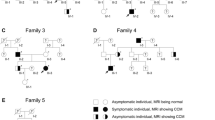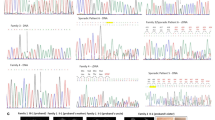Abstract
Cavernous malformations are angiographically occult, low-pressure neurovascular lesions with distinct imaging and clinical characteristics; main clinical manifestations are seizure, focal neurological deficits and epileptic attacks. Here we describe the molecular characterization of an Italian child, a symptomatic patient, affected by multiple cerebral cavernous malformations, without a family history of the disease and harbouring a new MGC4607 gene mutation. We identified two de novo missense variants in exon 6 of the gene both present on the same allele (cis configuration). DNA analysis for KRIT1, and PDCD10 gene variation through direct sequencing and MLPA analysis excluded further mutations. STR multiplex assay, allele-specific analysis and DHPLC analysis were performed for a better genetic characterization. Our findings emphasize the importance of the genetic test in subjects presenting multiple cerebral cavernomas for an adequate counselling, as well as for disease management since early identification of genetic abnormalities enable patients to have their lesions removed before they haemorrhage and cause deficit and/or epilepsy.




Similar content being viewed by others
References
Battistini S, Rocchi R, Cerase A et al (2007) Clinical, magnetic resonance imaging, and genetic study of 5 Italian families with cerebral cavernous malformation. Arch Neurol 64:843–848
Cavalcanti DD, Kalani MYS, Martirosyan NL, Eales J, Spetzler RF, Preul MC (2012) Cerebral cavernous malformations: from genes to proteins to disease. J Neurosurg 116:122–132
Cavé-Riant F, Denier C, Labauge P et al (2002) Spectrum and expression analysis of KRIT1 mutations in 121 consecutive and unrelated patients with cerebral cavernous malformations. Eur J Hum Genet 10:733–740
Chalouhi N, Dumont AS, Randazzo C et al (2011) Management of incidentally discovered intracranial vascular abnormalities. Neurosurg Focus 31:1–12
Craig HD, Günel M, Cepeda O et al (1998) Multilocus linkage identifies two new loci for a mendelian form of stroke, cerebral cavernous malformation, at 7p15-13 and 3q25.2-27. Hum Mol Genet 7:1851–1858
D’Angelo R, Marini V, Rinaldi C et al (2011) Mutation analysis of CCM1, CCM2 and CCM3 genes in a cohort of Italian patients with cerebral cavernous malformation. Brain Pathol 21:215–224
Davenport WJ, Siegel AM, Dichgans J et al (2001) CCM1 gene mutations in families segregating cerebral cavernous malformations. Neurology 56:540–543
Gianfrancesco F, Cannella M, Martino T et al (2007) Highly variable penetrance in subjects affected with cavernous cerebral angiomas (CCM) carrying novel CCM1 and CCM2 mutations. Am J Med Genet B Neuropsychiatr Genet 144B:691–695
Gross BA, Lin N, Du R, Day AL (2011) The natural history of intracranial cavernous malformations. Neurosurg Focus 30:E24
Guarnieri V, Muscarella LA, Amoroso R et al (2007) Identification of two novel mutations and of a novel critical region in the KRIT1 gene. Neurogenetics 8:29–37
Hauptman JS, Moftakhar P, Dadour A, Malkasian D, Martin NA (2010) Advances in the biology of cerebral cavernous malformations. Surg Neurol Int 1:63–69
Labauge P, Denier C, Bergametti F, Tournier-Lasserve E (2007) Genetics of cavernous angiomas. Lancet Neurol 6:237–244
Li DY, Whitehead KJ (2010) Evaluating strategies for the treatment of cerebral cavernous malformations. Stroke 41:S92–S94
Li X, Zhang R, Zhang H et al (2010) Crystal structure of CCM3, a cerebral cavernous malformation protein critical for vascular integrity. J Biol Chem 285:24099–24107
Liquori CL, Berg MJ, Squitieri F et al (2006) Low frequency of PDCD10 mutations in a panel of CCM3 probands: potential for a fourth CCM locus. Hum Mutat 27:118
Liquori CL, Penco S, Gault J et al (2008) Different spectra of genomic deletions within the CCM genes between Italian and American CCM patient cohorts. Neurogenetics 9:25–31
Marini V, Ferrera L, Dorcaratto A (2003) Identification of a novel KRIT1 mutation in an Italian family with cerebral cavernous malformation by the protein truncation test. J Neurol Sci 212:75–78
Miller SA, Dykes DD, Polesky HF (1988) A simple salting out procedure for extracting DNA from human nucleated cells. Nucleic Acids Res 16:1215
Miller CE, Quayyum Z, McNamee P, Al-Shahi SR, Steering Committee SIVMS (2009) Economic burden of intracranial vascular malformations in adults: prospective population-based study. Stroke 40:1973–1979
Muscarella LA, Guarnieri V, Coco M et al. (2010) Small deletion at the 7q21.2 locus in a CCM family detected by real-time quantitative PCR. J Biomed Biotechnol 2010. pii: 854737. doi:10.1155/2010/854737
Nannucci S, Pescini F, Poggesi A et al (2009) Familial cerebral cavernous malformation: report of a further Italian family. Neurol Sci 30:143–147
Pagenstecher A, Stahl S, Sure U, Felbor U (2009) A two-hit mechanism causes cerebral cavernous malformations: complete inactivation of CCM1, CCM2 or CCM3 in affected endothelial cells. Hum Mol Genet 18:911–918
Penco S, Ratti R, Bianchi E et al (2009) Molecular screening test in familial forms of cerebral cavernous malformation: the impact of the multiplex ligation-dependent probe amplification approach. J Neurosurg 110:929–934
Pileggi S, Buscone S, Ricci C et al (2010) Genetic variations within KRIT1/CCM1, MGC4607/CCM2 and PDCD10/CCM3 in a large Italian family harbouring a Krit1/CCM1 mutation. J Mol Neurosci 42:235–242
Revencu N, Vikkula M (2006) Cerebral cavernous malformations: new molecular and clinical insight. J Med Genet 43:716–721
Riant F, Bergametti F, Ayrignac X, Boulday G, Tournier-Lasserve E (2010) Recent insights into cerebral cavernous malformations: the molecular genetics of CCM. FEBS J 277:1070–1075
Stahl S, Gaetzner S, Voss K et al (2008) Novel CCM1, CCM2, and CCM3 mutations in patients with cerebral cavernous malformations: in-frame deletion in CCM2 prevents formation of a CCM1/CCM2/CCM3 protein complex. Hum Mutat 29:709–717
Tanriover G, Sozen B, Gunel M, Demir N (2011) CCM2 expression during prenatal development and adult human neocortex. Int J Dev Neurosci 29:509–514
Tonelli A, Lanfranconi S, Bersano A, Corti S, Bassi MT, Bresolin N (2009) Aberrant splicing due to a silent nucleotide change in CCM2 gene in a family with cerebral cavernous malformation. Clin Genet 75:494–497
Zawistowski JS, Stalheim L, Uhlik MT et al (2005) CCM1 and CCM2 protein interactions in cell signaling: implications for cerebral cavernous malformations pathogenesis. Hum Mol Genet 14:2521–2531
Acknowledgments
The authors would like to thank the index patient and her family for participation in this study, and the LICE for supporting a part of this study.
Author information
Authors and Affiliations
Corresponding author
Rights and permissions
About this article
Cite this article
Mosca, L., Pileggi, S., Avemaria, F. et al. De Novo MGC4607 Gene Heterozygous Missense Variants in a Child with Multiple Cerebral Cavernous Malformations. J Mol Neurosci 47, 475–480 (2012). https://doi.org/10.1007/s12031-012-9741-5
Received:
Accepted:
Published:
Issue Date:
DOI: https://doi.org/10.1007/s12031-012-9741-5




